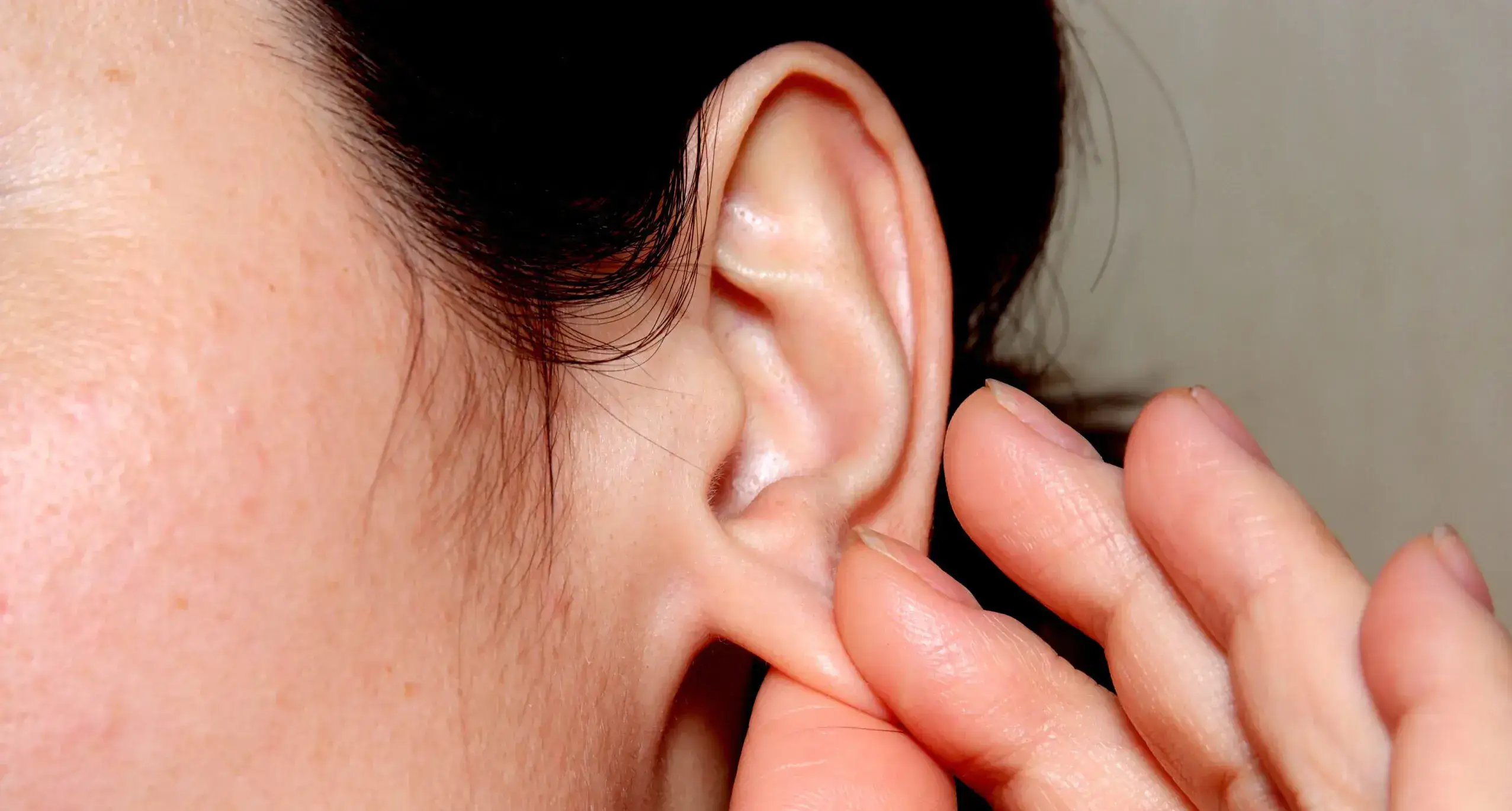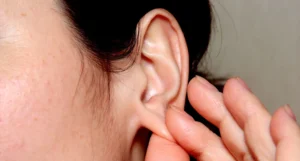Ever wake up with ear pain or a strange ringing in your ears? The way you sleep might be doing more than you think. New research shows that your regular sleep position can influence issues like ear infections, pressure, and even tinnitus.
Doctors now see strong links between how you rest your head and common ear problems. Sleep habits that seem harmless can actually cause pain, swelling, or worsen ringing, especially for side sleepers or those prone to infections. This post breaks down why your sleeping posture matters for ear health, how it’s connected to conditions like ear pain and vertigo, and what small changes can make nights more comfortable. Let’s take a closer look at what science says and share tips you can start using tonight.
The Anatomy of the Ear and How Sleep Positions Interact
Every night, the position you choose on your pillow sends subtle waves of pressure and gravity through your head—and straight to your ears. Understanding how ear anatomy works sets the stage for why sleeping positions can make such a difference, especially if you wake up with discomfort or ringing. Let’s break down what’s happening inside your ear and how lying on your side, back, or stomach can push and pull at these small but sensitive structures.

Photo by Kindel Media
A Quick Tour: Outer, Middle, and Inner Ear
Think of the ear as a three-part relay team. Each part has a job and each can react differently to outside pressure:
-
- Outer Ear: This is the part you see—the pinna (or auricle)—and the ear canal that runs inward. Its main task is to funnel sound. The cartilage in the pinna gives it flexibility, but that also makes it sensitive to being pressed against a pillow.
-
- Middle Ear: Hidden behind the eardrum, the middle ear is an air-filled space containing three tiny bones (the malleus, incus, and stapes). This system transmits vibrations and helps equalize pressure through the Eustachian tube, which links the ear to the throat.
-
- Inner Ear: Deep inside, the snail-shaped cochlea turns vibrations into nerve signals for hearing. The nearby vestibular system—those little loops and chambers—controls balance by sensing head movements and gravity.
Pressure, Gravity, and Ear Physiology
Your sleep posture does more than just crimp your neck. For your ears, pressure and gravity from your head and pillow can:
-
- Compress the outer ear: Especially in side sleepers, the cartilage of the pinna gets caught between skull and mattress. Over time this can cause discomfort, redness, or even sores (chondrodermatitis).
-
- Affect middle ear pressure: If one side of your head is down, it can make the Eustachian tube less effective at balancing pressure. This can lead to a plugged feeling or make you more prone to ear infections—especially if you’re already stuffed up.
-
- Shift inner ear fluids: The vestibular system relies on delicate balance fluids. Sleeping at unusual angles, or even quickly shifting positions, can briefly confuse this system. For some, especially those with vertigo or balance issues, the result is waking up dizzy or disoriented.
It’s almost like your ear is a level tool—each shift, squeeze, or tilt changes how it works. That means the way you lie in bed every night can truly affect how your ears feel and function when you wake up.
Sleeping position isn’t just about comfort for your neck or spine—your tiny, highly tuned ears are feeling every move too.
Common Ear Problems Influenced by Sleep Positions
Your favorite sleep position can impact your ears far more than you realize. The way you settle your head or press against the pillow has real effects on infections, pain, balance, and sound perception. It’s about more than just comfort—these small choices can stack up day after day, shaping your ear health. Here are the most frequently seen ear problems linked to sleep positions, backed by research and real-life solutions.
Ear Infections and Sleep Posture
Middle and outer ear infections can feel miserable at night, and the wrong sleep position can make symptoms worse. When you sleep flat or on the infected side, gravity can trap fluid in the ear canal or middle ear, raising pressure and pain. This happens because lying flush against the pillow blocks moisture and bacteria from draining easily, encouraging swelling.
Sleeping with your head slightly elevated helps fluid to drain, eases discomfort, and takes pressure off sensitive tissues. The best routine:
-
- Use extra pillows or a wedge to keep your head higher than your heart.
-
- Sleep on the side opposite the infection (if only one ear is affected).
-
- Avoid lying flat, since this can increase pain by hindering drainage.
Doctors and studies agree: a little elevation at night and careful side selection can improve sleep quality and speed up recovery. This approach is simple but surprisingly effective, keeping pressure in check and giving your body a better shot at healing.
Ear Pain and ‘Pillow Ear’

Photo by Kaboompics.com
Ever wake up with sore, red, or tender ears? “Pillow ear” is no joke—it happens when side sleeping or a stiff pillow squashes your outer ear against the bed for hours. All that pressure can:
-
- Cause chafing, sores, or bumps on the cartilage (sometimes called CNH—chondrodermatitis).
-
- Lead to ongoing pain, especially in people who sleep on one side or use firm, unyielding pillows.
Choose a soft or ergonomic pillow that supports your head without folding or pressing your ear. Some people swear by “pillow with a hole” designs, which eliminate contact altogether. It’s also smart to change up your sleeping side when possible and replace older pillows, which can harbor dust mites and lose their shape.
If you already deal with ear pain or sensitive skin, adding a gentle pillowcase and checking your head position before dozing off can make a big difference. Lower pressure means a better night’s rest and healthier cartilage over time.
Vertigo and Vestibular Disorders
For anyone with vertigo, sleep can bring dizziness and spinning that ruins rest. The link is in your inner ear, which is crucial to overall ear health. Some forms, like benign paroxysmal positional vertigo (BPPV), happen when tiny crystals shift in the balance canals, often triggered by certain head and body positions at night, impacting your ear health and balance.
Research shows:
-
- Lying on the “bad” side can launch vertigo episodes.
-
- Sleeping on your back with your head slightly raised helps prevent the crystals in your inner ear from sliding where they shouldn’t.
-
- Switching to the opposite side or using two pillows can shield you from the worst symptoms.
Therapies such as the Epley maneuver or specific head movements are proven to reposition those crystals and prevent night-time spins. Managing vertigo isn’t just about treatments—it also means supporting your ear health by setting up a sleep environment that keeps your head supported and pressure on the ear minimum. Even small tweaks to pillow height or sleep position can mean the difference between a rough and a restful night, helping maintain long-term ear health.
Tinnitus and Sleep Quality
Ear Ringing Tinnitus—the constant ringing, buzzing, or whistling in your ears—can become unbearable at night. Research highlights how sleep habits play a key role in how intense or distracting tinnitus feels.
Sleep issues and tinnitus can create a vicious cycle:
-
- Trouble falling asleep or frequent wake-ups can crank up your perception of sound.
-
- High arousal in the brain during restless nights means your ears seem louder, making it tough to relax.
-
- Nearly three-fourths of people with strong tinnitus report poor sleep, but improving sleep hygiene (like keeping a dark, cool room, managing stress, and sticking to a routine) can bring relief.
Some sound therapy, like using a fan or white noise, can also mask ringing and help your brain “tune out” the noise long enough to drift off. Interestingly, there’s no strong link between the extent of hearing loss and sleep quality—meaning healthy sleep habits matter more than your actual hearing levels.
Caring for your ears at night isn’t complicated, but the right sleep positions and a little awareness can spare you pain, prevent infection, and help you wake up ready for the day.
Risks of Poor Sleeping Posture on Ear Health
Poor sleeping posture does more than make you stiff in the morning—it can quietly strain your ear health over time. The way your head and neck align each night affects how fluids drain, how much pressure your ears endure, and how well the delicate structures inside your ear function. Ignoring these small stresses night after night can set off a domino effect, from stubborn pain to lasting problems with balance and hearing. Let’s break down both the short- and long-term risks, so you know what to watch for and how small changes can help you wake up feeling clear-headed.
Short-Term Risks: When a Night’s Sleep Causes Trouble
Even a few nights of poor sleep posture can leave your ears irritated or hurting. Side sleepers pressing one ear into the pillow put constant pressure on the cartilage and skin, which can impact ear health and lead to:
-
- Soreness, redness, or chafing (sometimes called “pillow ear”).
-
- Tender bumps or the beginnings of cartilage inflammation, especially if you don’t switch sides or use a hard pillow.
-
- Extra moisture trapping in the ear canal, ramping up the risk for ear infections—especially if you sweat at night or are prone to infections.
For anyone who deals with vertigo or balance issues, the wrong sleep posture can also aggravate symptoms:
-
- Sudden spinning or dizziness upon waking, especially if you roll or turn your head quickly in bed.
-
- Feeling unsteady or off-balance for the first hour after getting up.
When infection sets in, poor posture often makes things worse. Sleeping with the infected ear down or lying flat for hours can stop fluid from draining and stretch out an earache for several extra days.
Long-Term Risks: Cumulative Effects on Your Ears
The impact of poor sleep posture adds up over months and years. Chronic pressure, reduced drainage, and repeated strain can lead to changes that aren’t so easy to reverse.
Over time, you risk:
-
- Developing stubborn sore spots or pressure sores on the outer ear that can become long-term problems, especially in older adults.
-
- Worsening and prolonging ear infections. For repeat sufferers—kids, swimmers, or anyone with allergies—ignoring posture makes healing slower each time.
-
- Triggering more frequent or intense vertigo episodes, particularly if crystals in the inner ear move out of place night after night. Chronic vertigo affects daily balance and increases the chance of falls as you age.
-
- Increasing the likelihood of hearing decline in older adults. Research suggests that long-term reduced blood flow or repeated inflammation from pressure may slowly impact hearing function, especially in those already at risk from aging or noise exposure.
Who Is Most at Risk?
Some people need to pay special attention to sleep posture:
-
- Older adults: Skin thins with age, making pressure sores and cartilage damage more likely. Slower healing also means small wounds stick around longer.
-
- People with diabetes: Poor circulation means the ear can take much longer to recover from pressure or infection. Even minor sores can become serious.
-
- Anyone with past ear infections, chronic vertigo, or hearing trouble: Proper support can make the difference between a mild annoyance and a long stretch of discomfort.
Practical Tips for Protection
If you want to avoid these risks, focus on small nightly tweaks:
-
- Use a soft, supportive pillow—look for one with an ear cutout if you’re prone to pain.
-
- Change up your head position and avoid pressing one ear down night after night.
-
- Try elevating your head a bit, especially when your ears feel blocked or you’re getting over a cold.

Photo by Polina ⠀
-
- Keep bedding clean and dry—moisture plus pressure equals more opportunities for infection.
-
- Take special care if you’re older or have chronic health issues; even small adjustments have a big payoff.
Consistent good posture may not seem dramatic, but it plays a key role in maintaining ear health by handling the everyday pressure of sleep. Small nightly choices can help you protect your hearing, prevent infection, and keep vertigo at bay—all while sleeping better than ever.
The Best Sleeping Positions for Ear Health and Recovery
Choosing how you sleep can make a real difference when it comes to ear pain and healing. The right sleeping position helps your ears drain fluid, eases pressure, and can speed up recovery from infections or injury. Small changes, like using a special pillow or picking the best side, are more than just comfort choices—they’re core steps for better ear health.
Techniques to Reduce Pressure and Support Drainage
Sleeping with ear pain or during recovery isn’t just about comfort—it’s about supporting ear health so your ear can heal while you rest. Here’s how you can ease pressure and help your ears recover:
-
- Elevate your head. Lifting your head 30–45 degrees with extra pillows or a foam wedge helps fluid drain out of your ears naturally. This takes strain off sore or infected tissue, so you don’t wake up feeling worse.
-
- Pick the optimal sleep side. If you have an ear infection or a ruptured eardrum in one ear, always sleep with the healthy ear down. This stops pressure building up in the injured ear and allows the infection to drain.
-
- Back sleeping is best if both ears are sore. When both ears are sensitive—like after ear surgery or during a double ear infection—lying on your back with your head supported is safest. This keeps pressure off both sides and lets healing happen evenly.
-
- Use specialized pillows. Medical pillows for ear health often come with soft memory foam and a cut-out or “donut” section. This lets your ear avoid contact with the pillow, reducing pain, swelling, and even “pillow ear” (the red or sore spot from hours of pressure).
-
- Try ergonomic sleep accessories. Adjustable pillows, modular layers, and cooling pillowcases (like bamboo or hypoallergenic fabrics) cut down on sweat and keep moisture away from your ears. These features also help keep your head and neck in line, so ears aren’t pinched or stretched at weird angles.
-
- Avoid stomach sleeping. Lying face down squashes your ears against the mattress, trapping moisture and blocking drainage. Stick with side or back sleeping for best results.
The right sleep tools can make a tough night much easier, especially if you’re dealing with repeated earaches or recovering from surgery. Investing in the right pillow isn’t just a luxury—it’s a practical fix to support ear health, help your ears heal faster, and reduce discomfort.

Photo by Jonathan Borba
Lifestyle and Environmental Adjustments
Supporting your ear health at night isn’t only about how you position your pillow. Smart lifestyle tweaks and setting up your bedroom environment also make a real impact:
-
- Stick to a regular sleep schedule. Going to bed and waking up at the same time every day trains your body’s clock and can reduce inflammation flare-ups linked to poor rest.
-
- Use a humidifier, especially in dry climates. Dry air can irritate the ear canal, worsening discomfort or infection. Adding moisture helps prevent crusting and keeps the ear canal more comfortable.
-
- Keep your bedding and pillowcases clean. Bacteria and dust can aggravate ear infections and skin irritation. Wash your pillowcase often—especially if you’ve been sick.
-
- Skip earplugs if you have infections. While it’s tempting to block out noise, earplugs can hold in moisture and block drainage, feeding infection risk.
-
- Protect ears from water before bed. Dry your ears fully after showers and avoid swimming late at night to lower your risk of trapped moisture.
-
- Avoid inserting anything into the ear canal. Cotton swabs, hairpins, or earbuds can scratch the skin and introduce bacteria. Let your ears drain on their own while you rest.
Regular supportive habits add up. When you focus on both sleep position and your sleep environment, you support ear health and give your ears the best shot at staying healthy all night long. These steps work together like a safety net, catching small issues before they turn into lasting problems.
Practical Tips for Sleeping Comfortably with Ear Issues
Ear health plays a big role in how well you sleep. Sleeping soundly gets tricky when your ears are acting up. Whether you deal with sharp pain from an infection or face chronic ear troubles, maintaining good ear health with the right steps can protect your ear—and your sleep. This section covers practical strategies for managing flare-ups and long-term comfort, so you can wake up refreshed instead of irritated.
Managing Acute Pain and Swelling: Advice on using warm compresses, over-the-counter medications, and safe sleeping postures during acute episodes
Acute ear pain or swelling can turn bedtime into a struggle. The simplest tweaks can help you rest easier until the problem passes.
Apply gentle warmth:
-
- Use a warm (not hot) washcloth or heating pad against the sore ear for 10–15 minutes before sleep. This eases inflammation and soothes discomfort.
-
- Always wrap heating pads with a towel to avoid burns.
Take the right medication:
-
- Over-the-counter pain relievers like acetaminophen or ibuprofen can take the edge off the pain.
-
- Follow package directions and check with your doctor if you have other health conditions.
Choose your sleep position wisely:
-
- Sleep on your back or with the affected ear up. This helps fluid drain and limits throbbing.
-
- Elevate your head with extra pillows or a wedge to further cut down on pressure.
-
- Avoid sleeping with your sore ear pressed into the pillow, as direct compression worsens swelling and pain.
Keep your environment comfortable:
-
- Use a soft, supportive pillow—special pillows with an ear cutout can prevent extra pressure.
-
- Maintain a cool, dry bedroom; use a clean humidifier if dry air worsens symptoms, but don’t let it get damp.
Sticking to these basics helps most people get through a rough ear night. If pain gets worse or lasts more than a day or two, it’s smart to let your doctor know.
Long-Term Strategies for Those with Chronic Ear Conditions: Discuss regular monitoring, integrating positional change routines, and consulting healthcare professionals
Chronic ear problems call for a steady game plan. Small, consistent actions protect your hearing and support better sleep, night after night.
Regularly check your ear health:
-
- See an ear specialist every few years, or more if you have a history of infections or hearing loss.
-
- Track changes in your symptoms, including new pain, dizziness, or ringing at night.
Make positional changes a habit:
Ear health starts with everyday habits—including how you sleep.
-
-
Rotate your sleeping side through the week to prevent “pillow ear” and reduce uneven pressure.
-
Consider back sleeping with your head slightly elevated for balance.
-
Use pillows designed for ear comfort if you’re a side sleeper—they reduce direct pressure and improve airflow.
-
Keep your sleep routine ear-friendly:
-
- Avoid loud noises at night—even snoring or city sounds—since chronic noise can worsen ear fatigue and tinnitus. Try white noise machines or noise-canceling headbands that don’t block or plug the ear canal.
-
- Stick with bedding and pillowcases made from clean, breathable fabric. Damp, dirty linen increases infection risk.
Partner with a healthcare professional:
-
- Audiologists and ENTs can guide you on advanced solutions, whether it’s hearing checks, managing tinnitus, or choosing ear-friendly sleep aids.
-
- If you wear hearing aids, ask your provider about best nighttime care, as some types need to be removed before sleep to prevent irritation.
Daily habits matter too:
-
- Keep your ears dry and clean, especially after showers or swimming.
-
- Don’t poke or scratch inside your ear canal—let any drainage occur on its own.
-
- Protect your ears from loud, sudden noises with earmuffs or over-ear headphones if you’re sensitive.
These long-term steps build a better foundation for ear health and restful sleep. A steady routine means fewer painful nights and more mornings when your ears feel just right.
Conclusion
Your nightly sleep habits play a bigger role in ear health than most people realize. Simple changes, like adjusting your sleeping position or using the right pillow, bring real relief and can prevent ongoing problems. Ear pain, infections, vertigo, and ringing often improve when you give your ears the right support at night.
Taking care of your ears starts with small choices in your routine. Don’t ignore ear pain, balance issues, or changes in hearing—make adjustments and reach out to an ear specialist if problems stick around.
Thanks for letting this guide be part of your bedtime. Share your own sleep tips below or reach out if you need more ideas to protect your ear health in the future.







